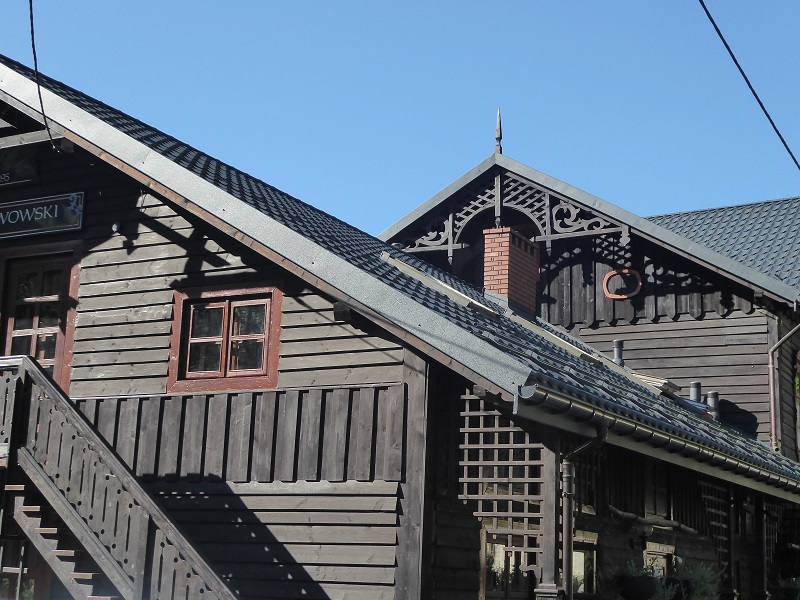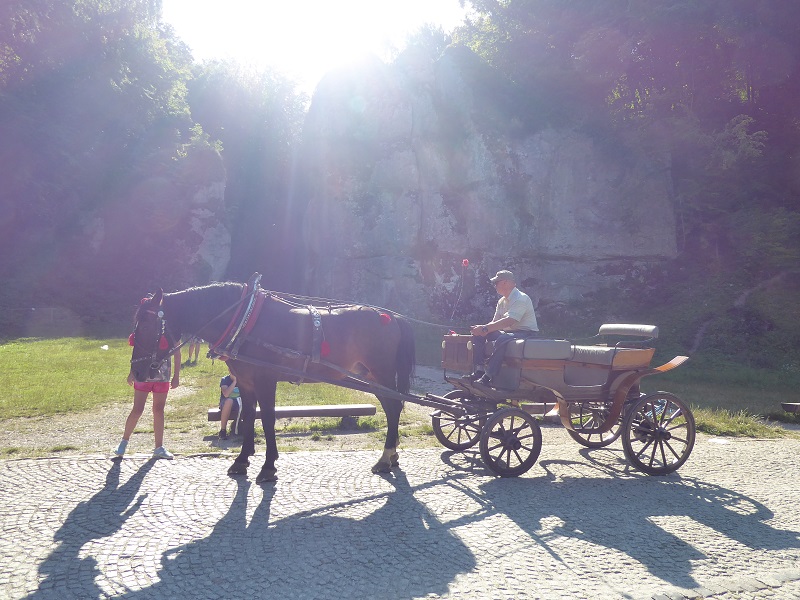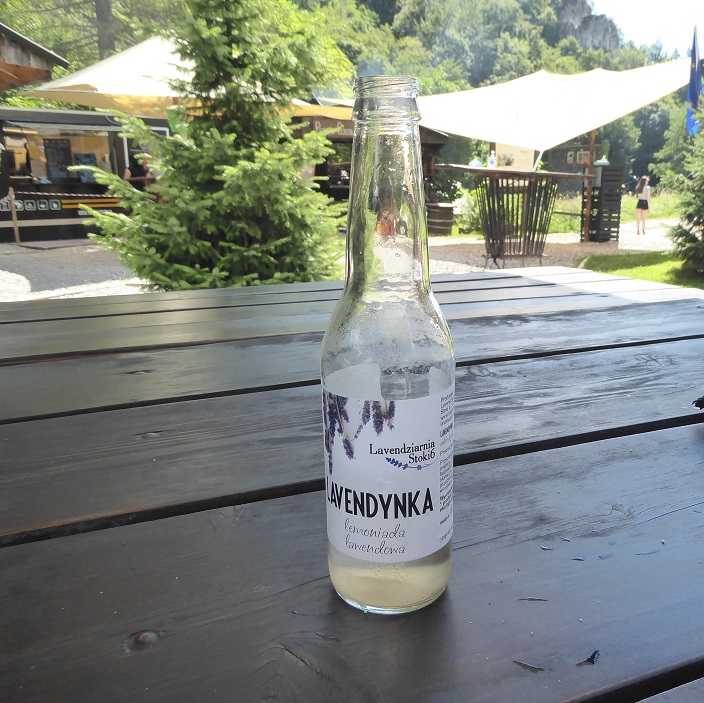Our early start to miss the crowds paid off in every way, other than making us fugitives from the law.
‘Buildings in Ojców’ featured on the campsite’s list of ‘must sees’. This rather underwhelming description prompted us to take a drive out one evening to check their credentials. The quaint wooden houses and lush, pastoral scenery suggested at least ‘worth a gander’, although the heaving mass of humanity crammed on to every footpath was off-putting enough to take us way off piste.
We set an alarm for 6am.

For Mark and I, a working life filled with 4am commutes to London removed the sheen from early starts. Now, with the daily option of either a lie-in or an afternoon nap, I don’t know why we don’t do it more often. Just the pale honey-coloured stillness of a summer morning is well worth rolling out of bed for.
Since our van, Big Blue, was the sole occupant of the deserted car park beneath the ruins of Ojców Castle, we had a luxurious choice of shady spaces. Big Blue’s aircon packed up weeks ago in Provence, so it was a relief to know that driving back to the campsite would not leave us gasping like goldfish trapped in a hydrothermal vent.
The paths were devoid of jostling crowds, allowing us to linger and admire the ornate filigree carvings on the houses. We climbed a deserted promontory above the village and felt like planting a flag to claim the vista along the Prądnik valley. Shimmering limestone cliffs and the bone-white cylindrical turret of the castle shone in the honeyed light, framed by opulent tousles of greenery.

As we dropped from our knoll, we passed a series of tranquil pools. Unknown to us, Ojców trout is a famous delicacy. The valley’s microclimate and the crystal-clear waters of the Młynówka stream, oxygenated by a waterfall, provide the perfect habitat for brown trout. We noted a scatter of shaded wooden tables and a rustic barbeque on the lawn surrounding one pond and shared a thought; “That’s lunch sorted!”
At the end of the footpath, beyond the trout hatchery, we came face-to-face with two towering boulders. Each around fifteen-metres high, they form Brama Krakowska – the Kraków Gate, a narrow, foreboding yet entirely natural portal into the forested gloom of the gorge beyond. The gateway formed part of the principal trading route between Kraków and Silesia, now replaced by the metalled road along the floor of the Prądnik valley.

A few yards from the gate is Jaskinia Krowia – the Cow Cave. The cavern was formerly used to shelter sheep or cattle, and latterly used as an ice house and film set.

Źródło Miłości – The Spring of Love used to bubble up from the left pillar of the Kraków Gate. Legend has it that a sip from this spring will bind couples eternally; you can trace this ancient wisdom all the way back through the mists of time to Ojców’s first tour guides!
The Spring of Love moved when a mineral water company gave it a romantic re-route through a ditch under the road to a now demolished bottling plant. These days, the water bubbles out over a lovey-dovey slab of concrete opposite the Gate. According to the explanatory placard, Źródło Miłości has adopted new and much dreamier name; ‘The Secondary Love Source’. With the Cow Cave in mind, we surmised that taking the waters was more likely to perpetuate E. Coli than everlasting adoration.
Following a figure of eight route, we planned to return triumphant through the Kraków Gate later, so after a brief exploration of the Cow Cave, we continued up the valley. The cobbled road was a delight. As it wound its way through rustling meadows, it played a meandering duet with the Prądnik river. Limestone cliffs festooned with vegetation stood guard on either side, while an occasional timber house shimmered like a mirage, nestled in its idyllic setting. A golden silence surrounded us, interrupted only by the muted background of birdsong, insects and the river.
The pups added an explosion of exuberance to the day with an abandoned splash in the clear waters, just before we reached a little coffee shop. Kawiarnia Niezapominajka is allegedly famous for cakes and special Polish pancakes filled with cream cheese and sugar. It was too early to sample its wares, but as an almost messianic convert to bacon, banana and cheese jacket potatoes in Zimbabwe, I’d urge you not to knock it until you’ve tried!
Before you could say Kawiarnia Niezapominajka, we found a conveniently staired pathway and struck upwards into the fresh green forest. It led to the Okopy plateau, an extensive area protected by sheer drops on most sides. Woodland now conceals the remains of the 13th Century Wisegrod hill fort, but for millennia before that, Okopy provided a perfect refuge for people and livestock. Evidence of habitation on the plateau goes back to the Neolithic.

A dusty pathway along the top of the ridge seemed too much for Rosie. She rolled enthusiastically until our smartly contrasting white and black dog achieved the indistinct, ashen hue of a laundry accident. (My brother achieved the zenith of washday woe when, to save time, he put all his clothes into the machine at once. Undaunted, his characteristically optimistic spin on the sombre, washed-out results was; “I’ve always wanted a matching wardrobe!”)
We put Rosie’s rolling down to high jinks. However The Curious Incident of the Dog in the Light Grime is a mystery we wouldn’t solve until we reached our next destination.

Gaps through the trees offered tantalising glimpses of the picturesque vale and its ragged, chalky walls. At one point, we found the viewpoint that overlooked Skała Rękawica – The Glove Rock. This five-fingered formation looks for all the world like a giant Jurassic hand, eighty-five metres up, waving travellers on their way through the Kraków Gate.

On the subject of gloves, the time had come. It forced us to run the gauntlet through the morning’s first stampede of tourists as they swarmed up to tick off The Glove Rock. As we descended the steep steps through the throng, we passed the entrance to Jaskinia Ciemna – The Dark Cave; also known as The Ojców Cave. 120,000 years ago, it was home to humans and is one of the most important archaeological sites in Poland. Excavations discovered more than a thousand stone tools, which are now on display in the museum.
To sate any pressing desire for visitors to know what a family of naked Neanderthals might look like, a plastic 3D installation is provided. Unfortunately, we missed this Stone Age selfie stop because social distancing is tricky in a 230-metre tunnel. Understandably, the cave was closed due to Covid restrictions.
I was a little disappointed, since a clue to one particular charm of The Dark Cave is in its title. As you might expect from a 150-million-year-old cavern, it has no mod-cons like electricity. Guided tours are conducted by candlelight, which sounds rather lovely.
The cave gave me a sudden urge to test Mark’s subterranean scholarship,
“How do you tell the difference between stalactites and stalagmites?”
He noted my grin and gave me a resigned, “Go on…”
I was educated at a Convent school, where my Geography mistress, Miss Taylor, tutored,
“Stalactites grow on the ceiling, so they hold on tight.”
However, a backpacker in Oz taught me a strikingly different denotation for dripstone differentiation:
“Toights come down!” I repeated gleefully, in my best Australian accent.
Tights coming down was definitely not on the Convent curriculum. Indeed, that was exactly the sort of thing my saintly sex education aimed to prevent. The nuns offered up a single straightforward solution to avoid sin, which was,
“Don’t do ‘it’!”
‘It’ being a euphemism for… well. You know. That thing you learn in Biology.
In a vague nod to the real world, they did equip us with additional practical advice,
“If you must sit on a young man’s knee, place a thick book beneath your bottom,” and “Don’t wear patent leather shoes, as they show off your knickers!”
Mark and I emerged from the forest, squinting into serious sunlight. As we strode triumphant through the Kraków Gate for the second loop of our figure of eight, the scene was very different. High-heeled horses and traps disgorged cartloads of tourists before reloading to trot back along the cobbles to Ojców.

We dodged back into the forest’s coolness, where a pleasant ramble away from the crowds led gently uphill to Grota Lokietek, also known as the Royal Cave. Ironically, Ojców’s largest cave is named after Poland’s smallest ruler.

A diminutive Duke, Władysław Łokietek, or ‘Władysław the Short’, allegedly used the cave as a hideout while at war with Bohemian ruler Wacław II. As Kingly cognomens go, his other name, ‘Władysław the Elbow High’, is not the worst. I know of one Shit (James the Shit of England, Ireland & Scotland), a Cabbage (Ivailo the Cabbage of Bulgaria) and at least three Bastards. The best known Bastard is William I of England, although he did prefer to be called ‘Conquerer’.
The tall tales surrounding this pint-sized Polish prince say he escaped death when an obliging arachnid spun a web to cover the entrance to his secret passage. What else can I tell you about cave-dwelling Władysław Łokietek?
‘Though he be but little, he is fierce.’
I know. I misquoted.
Shakespeare’s sisters were the feisty ones, but just like the girls in A Midsummer Night’s Dream, Łokietek got his happy ending. He defeated his enemies, got crowned King of Poland in 1320 and ruled happily ever after. Up until 1333, at least, when the ‘ominous and fearful owl of death’ swooped in for a visit.

The finest fish I have ever tasted was a fillet of Arctic Char, experienced in the Swedish Ice Hotel on the occasion of Mark’s fortieth birthday. Our lunch at Pstrag Ojcowski came the closest yet to toppling this spectacular Salmonidae from its near two-decade reign atop our piscatorial podium. The lightly smoked trout was soft, sweet and juicy. Caught in the pond next door and cured on the premises by a mother and daughter team, it was almost fresh enough to boast negative food miles.
I’m sure location enhances the pleasure of food. To complement our flavoursome Arctic Char, we had ice plates, ice glasses and a glistening melting ice sculpture, all hewn from crystal clear chunks of the frozen River Torne. In contrast, a tinkling stream, balmy sunshine and the scent of summer accompanied the earthy flavours of our trout. Washed down with lavender-flavoured lemonade, that fish still features in my foodie fantasies!

After our delightful lunch, it was a short skip back to explore the ruins of Ojców Castle. King Kazimierz III Wielki – Casimir the Great, son of The Elbow High, built the castle. He was the ruler who welcomed Jewish people into Kraków; which is why they named their famous Jewish quarter ‘Kazimierz’ in his honour.
Along with Pieskowa Skała just up the road, Ojców Castle is one of a chain of twenty-five medieval castles and watchtowers which comprise The Trail of the Eagles’ Nests. In the 14th century, Kazimierz III built many of these strongholds to form a defensive line between his Poland and the Bohemian Kingdom of Silesia to the south. The Trail runs approximately 100 miles (163 km) from Kraków to Częstochowa. Obviously, it derives its name from the lofty locations of the fortifications, many of which are built on the steep limestone rocks and bluffs of the Polish Jura.
As you do when you’re following tourist routes, we kept running into the same faces.
“You’re dressed as the Polish flag!” Mark said to one chap who stopped with his family to fuss the dogs in the forest. At first, he looked confused,
“You’re wearing a white T-shirt with red shorts!”
“It’s not deliberate!” he laughed when Mark clarified.
Yet it was quite appropriate on the anniversary of the Warsaw Uprising; something of which we would discover much more later.
We met Mr Flag Man again at the castle. I was still struggling with pronunciation, so I asked him to remind me how to say Ojców,
“Oyt-Zov.”
I scrawled it on my hand in biro and to Mark’s delight, repeated it like a mantra for the rest of the day.
“Ojców comes from the Polish word for ‘father’,” Mr Flag explained. “Kazimierz named the castle for his father,” – that Elbow High guy again.
Though he be but little, he was clearly held in high regard.
Like many of the Eagles’ Nests, Ojców Castle is mostly in ruins. The restored tower was closed for Covid reasons, but the site’s elevated position still gave us a splendid view along the valley.
Back at the car park, we got a nasty shock. Every space was rammed full, with a car conga dribbling out on to the road. Mark lifted a piece of paper from our windscreen. Covered in undecipherable hieroglyphics, the only part we understood was a number followed by the symbol for Polish złoty.
It was a clear case of the early bird gets the parking ticket.
We scanned the area, but as when we arrived at first light, there was no sign of a parking attendant to collect our money. What could we do?
Mark and I are upright and law-abiding citizens! Although I’m ashamed to admit that insurgency is not new to me, albeit my crimes were inadvertent.
Warsaw’s famous son, Fryderyk Chopin visited Ojców in 1829. Once, at a party, I performed Beethoven on a piano reputedly played by Chopin while I was Brahms and Liszt. I didn’t realise how seditious my drunken recital was. Luckily, it took place in Scotland, and years after the end of Soviet rule in Poland. In a different time and place, it could have been insurrection by association!
In 1977, the B.B.C. banned The Sex Pistols ditty ‘God Save The Queen’. Would you believe that classical composer Chopin was so synonymous with Polish nationalism that Tsarist Russia deemed his music subversive and forbade celebrations of his birth? The Nazis took it much further and banned him completely. Under German occupation, a soiree with Chopin was punishable by death!
If we’d had the slightest clue how to do so, we would have paid the fine. Instead, like Bonnie and Clyde, Mark and I withdrew furtively from the car park and went on the run. We hoped that for the rest of our stay in Ojców, a large blue van with British plates might slip beneath the radar – and that the long arm of the law in Poland might be modelled on someone the size of Łokietek.

When they are open, dogs are not allowed in the caves. Year round, the temperature inside the caves is around 7°C, so take suitable clothes. The caves are popular, so at peak times, booking a tour is advisable – and don’t forget to pay for parking!
Join us next time when we visit Ogrodzieniec Castle, voted the year’s No. 1 tourist attraction.
We LOVE likes, comments and follows! If you want to walk with us and get automatic notification of new posts, please enter your email address in the box, or if you’re a WordPress user, click the ‘Follow’ button. Thank you for reading!

The piano played by Chopin (above) is in the Landmark Trust property Gargunnock House, which is available for rent and comes highly recommended for a seditious Scottish sojourn once lockdown ends!






Glove rock looks amazing! I love your descriptions of the scenery, it makes you feel like you’re there. Very enjoyable.
LikeLiked by 1 person
Thank you Glenys. I’m pleased you enjoyed it and it’s good to know the descriptions meet my intent! Thanks for commenting.
LikeLiked by 1 person
Love the Glove Rock too! Looks lovely. Thanks for sharing!
LikeLiked by 1 person
Glad you enjoyed it!
LikeLike
Beautiful photo – great composition!
LikeLiked by 1 person
Thank you, Gail! Your kind words are much appreciated.
LikeLike
I love the photo of glove rock and St. Joseph chapel. The castle looks cute too.
LikeLiked by 1 person
It’s a lot of beautiful things crammed into a very small area!
LikeLike
Krakow Gate (with the Fab Four in front) is a beauty of a picture!
And I’m totally with you regarding location and food … tried it myself many times before and there is definitely truth in this 😉.
LikeLiked by 1 person
Thank you!
LikeLike
The landscape is wonderful, isn’t it? I’d have loved to see much more, even though it was a grey and drizzly day when we were there. 🙂 🙂
LikeLiked by 1 person
We were so lucky with the weather. It was the end of July and we had wall-to-wall sunshine. The landscape is so beautiful, I would love to spend more time there. I saw your photos; the mist makes it quite moody, but it’s always lovely to walk in the sunshine!
LikeLike
Ojcow is a stunning place. I love how quiet it’s there – you don’t hear the noise of modern life. It is a wonderful oasis to unwind and recharge.
LikeLiked by 2 people
Beautiful captures!!! Loved the Glove Rock pic!
LikeLiked by 2 people
Thank you – it’s a stunning landscape. Right up your street, I suspect!
I LOVE your photos. 🙂
LikeLiked by 2 people